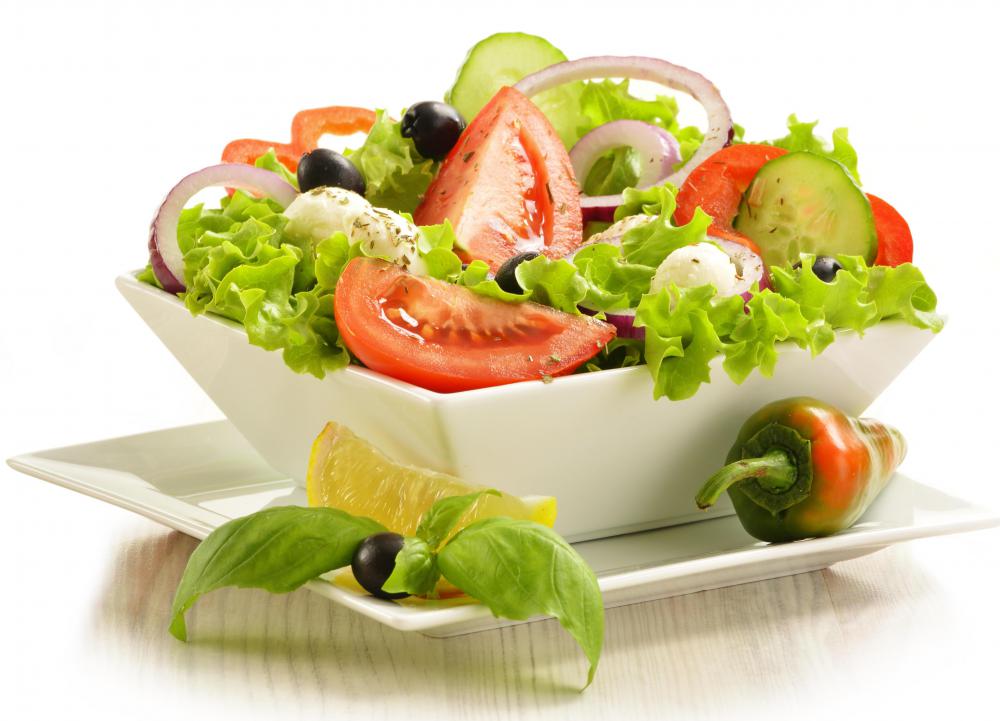At DelightedCooking, we're committed to delivering accurate, trustworthy information. Our expert-authored content is rigorously fact-checked and sourced from credible authorities. Discover how we uphold the highest standards in providing you with reliable knowledge.
In Cooking, what is a Cold Water Bath?
A cold water bath is a cooking technique that immediately arrests the process of whatever a person is cooking by directly immersing it in cold or even ice water. The simplest method is to pour cold water on foods like pasta while it still sits in the colander. This can help keep the pasta al dente for recipes like pasta salad. Placing food in cold water is also common when a cooks is blanching, or lightly cooking, vegetables for use as a side and in salads.
The reason chefs employ a cold water bath is because food that is heated will continue to cook slightly, even after it is removed from the heat. When a cook is minimally cooking food and needs it to retain a certain texture or firmness, he can still end up overcooking it if it's not cooled quickly. This may also be called shocking the food, since its result is to immediately end the cooking process.

Sometimes people add salt to the water, about 0.5 teaspoon (3 g) for every quart (liter) of water used. This can help the food retain its natural sodium, though many skip this step with fine results. The simple bath is composed of lots of ice covered in water. Some recipes recommend that cooks fill a bowl about two-thirds with ice, and then add enough water to cover it.

Food like blanched vegetables are then placed in the cold water bath and allowed to sit for a minute or two. They can then be removed and will not cook further. Cooks can store most vegetables that have been shocked for a few days in the refrigerator. They may want to consider placing them in airtight bags or lidded containers to keep them fresh. The vegetables should also be dried slightly if they will be stored, so that excess moisture does not ruin them.
This method should not be used for pasta when the cook plans to keep the food hot and serve it immediately. In fact, many recipes for pasta should not include a shock process, since even pouring cool water over pasta can remove the starchy coating pasta gets when it is cooking. This starch may be necessary when pasta is added directly to thin sauces, since it helps to thicken them. Similarly, if a cook is adding hot potatoes to thin sauces or soups to make them thicker, they should not be rinsed or shocked.
AS FEATURED ON:
AS FEATURED ON:












Discussion Comments
I would just lie to add that you can successfully shock pasta in water that you are planning to use immediately. I worked in the restaurant industry for years, and I always shocked the pasta for consistency reasons. The trick is to flash heat the past just before serving.
I cook the noodles to a perfect al dente, shock the pasta to firm it up slightly, and then drop the pasta in a hot water bath for one minute before plating. I also season the water with a touch of sea salt and some EVOO to give the pasta that perfect flavor. The pasta is always perfect whether I serve it five minutes after being cooked, or five hours after being cooked.
If you want to make your own frozen vegetables, you should blanch them and then shock them in a cold-water bath. Blanching the vegetables for 30 seconds to two minutes, depending on the vegetable, will allow it to retain its color, flavor, and taste after a month or two in the freezer. This is cheaper than buying previously frozen vegetables, and you can ensure the vegetables are as fresh and high quality as you like.
Once a month I spend a couple of hours blanching and freezing vegetables that I plan on freezing. I can make my own custom frozen vegetable mixes using the freshest organic produce, and I can control the size of the bag of frozen veggies (Who wants to eat the second half of a bag of frozen veggies that has been sitting in the freezer for two weeks!). I simply blanch the vegetables, shock them in cold water, and spin them in a salad spinner before dividing them into freezer bags.
Post your comments